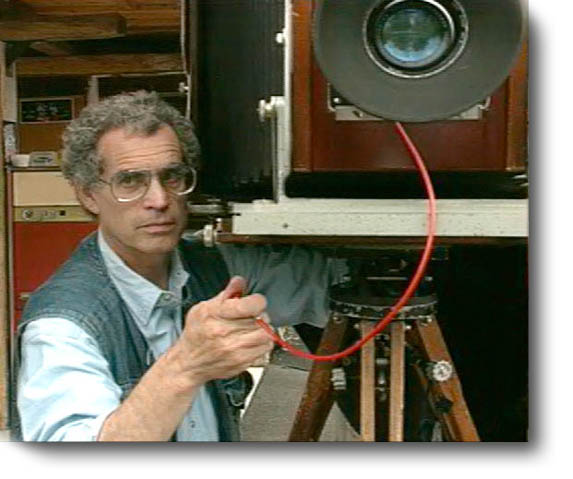Our Way of Working
 The materials and
equipment we use are the same as those available fifty years ago. We don't use them for the sake of tradition; it is just that we have not found anything better in modern materials and equipment.
We use Ries tripods, and our 8x10-inch cameras are old Kodak MasterViews. Occasionally we use 5x7 and 4x5 reducing backs on the 8x10s to make smaller and more intimate pictures. We do not make
photographs to be enlarged, but see them as contact prints from the beginning. The 8x20 camera is an old Deardorff and the 18x22 is an ancient Empire State. The materials and
equipment we use are the same as those available fifty years ago. We don't use them for the sake of tradition; it is just that we have not found anything better in modern materials and equipment.
We use Ries tripods, and our 8x10-inch cameras are old Kodak MasterViews. Occasionally we use 5x7 and 4x5 reducing backs on the 8x10s to make smaller and more intimate pictures. We do not make
photographs to be enlarged, but see them as contact prints from the beginning. The 8x20 camera is an old Deardorff and the 18x22 is an ancient Empire State.
Our
lenses are old Goerz Dagors and Artars from 6 1/2" all the way up to 35". For our negatives, we use the last of the old style emulsions Kodak's Super XX (now discontinued), and develop
them in ABC Pyro. We make our prints on Kodak's Azo, the last of the silver chloride contact printing papers, and develop them in Amidol.
We usually carry about half a dozen film holders with us in the field unless we have an assistant
to carry more (we travel with about twenty or thirty 8x10 holders and
six 8x20 holders in the photography truck), and we don't get too concerned
about dust in the holders regardless of where we're working. (The more
you mess with them, the more dust you attract. It seems dust is equally
attracted to static electricity and anxiety.) Although our equipment is
large and cumbersome, we try to keep it as simple as possible.
We use Super XX film because it yields the longest
and smoothest range of tones from black to white. In terms of the Zone System, Super XX can hold a tonal range several steps longer than modern films. Super XX, the last of the old style thick
emulsion films was discontinued in 1994. At that time we bought the last of Kodak's remaining supply.
 We develop our film by inspection and hand develop about eight to ten at a time in trays.Why
make only contact prints? We find that contact prints when made on Azo have a richness that imparts a kind of glowing presence and depth that seems impossible to achieve in an enlargement. So
when we want larger prints, we have to use larger negatives and must therefore use larger cameras. When using larger cameras, every aspect of making the picture becomes exponentially more difficult.
We bother with all of this because we believe that contact prints on Azo yield incomparable quality in the print. We develop our film by inspection and hand develop about eight to ten at a time in trays.Why
make only contact prints? We find that contact prints when made on Azo have a richness that imparts a kind of glowing presence and depth that seems impossible to achieve in an enlargement. So
when we want larger prints, we have to use larger negatives and must therefore use larger cameras. When using larger cameras, every aspect of making the picture becomes exponentially more difficult.
We bother with all of this because we believe that contact prints on Azo yield incomparable quality in the print.
|

